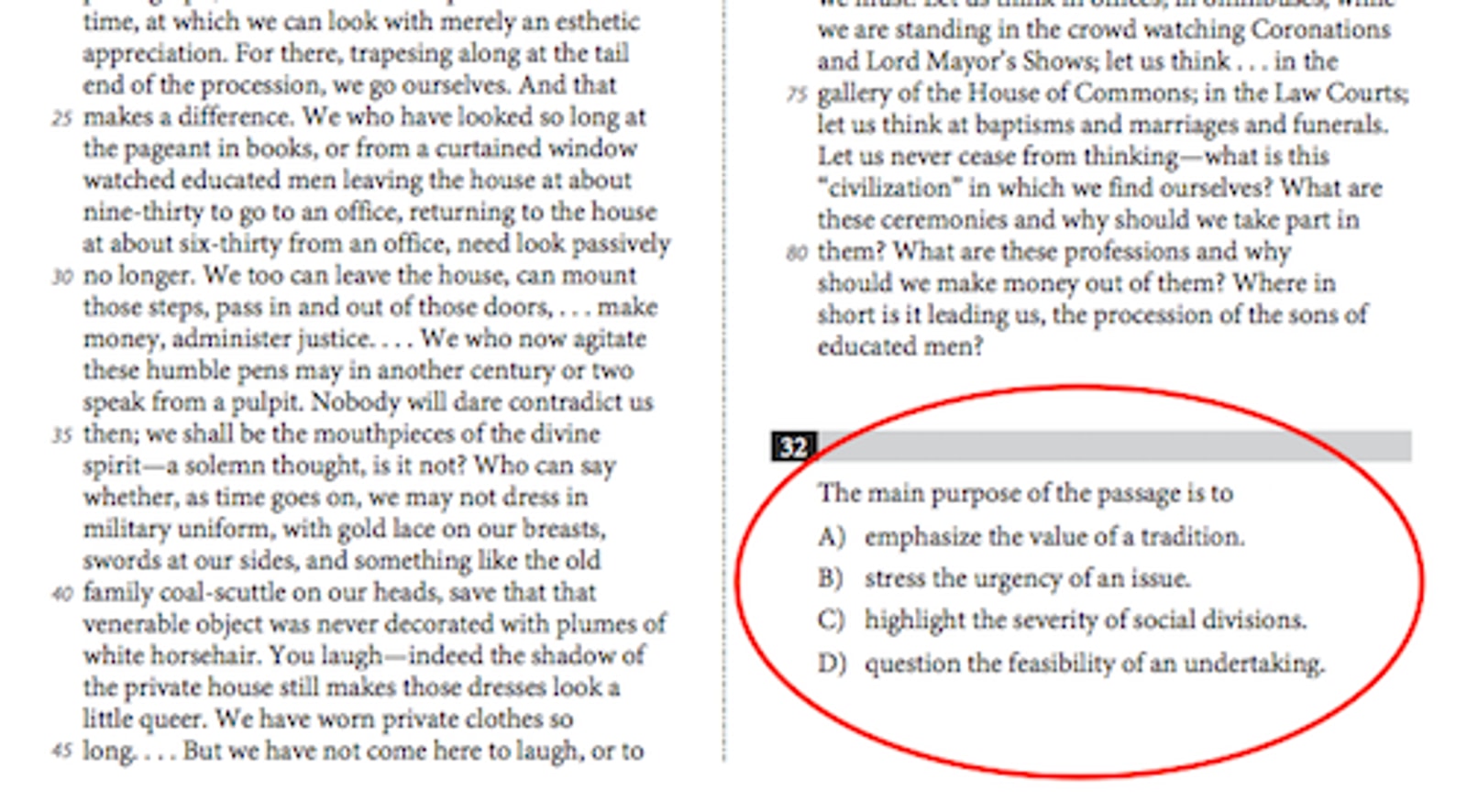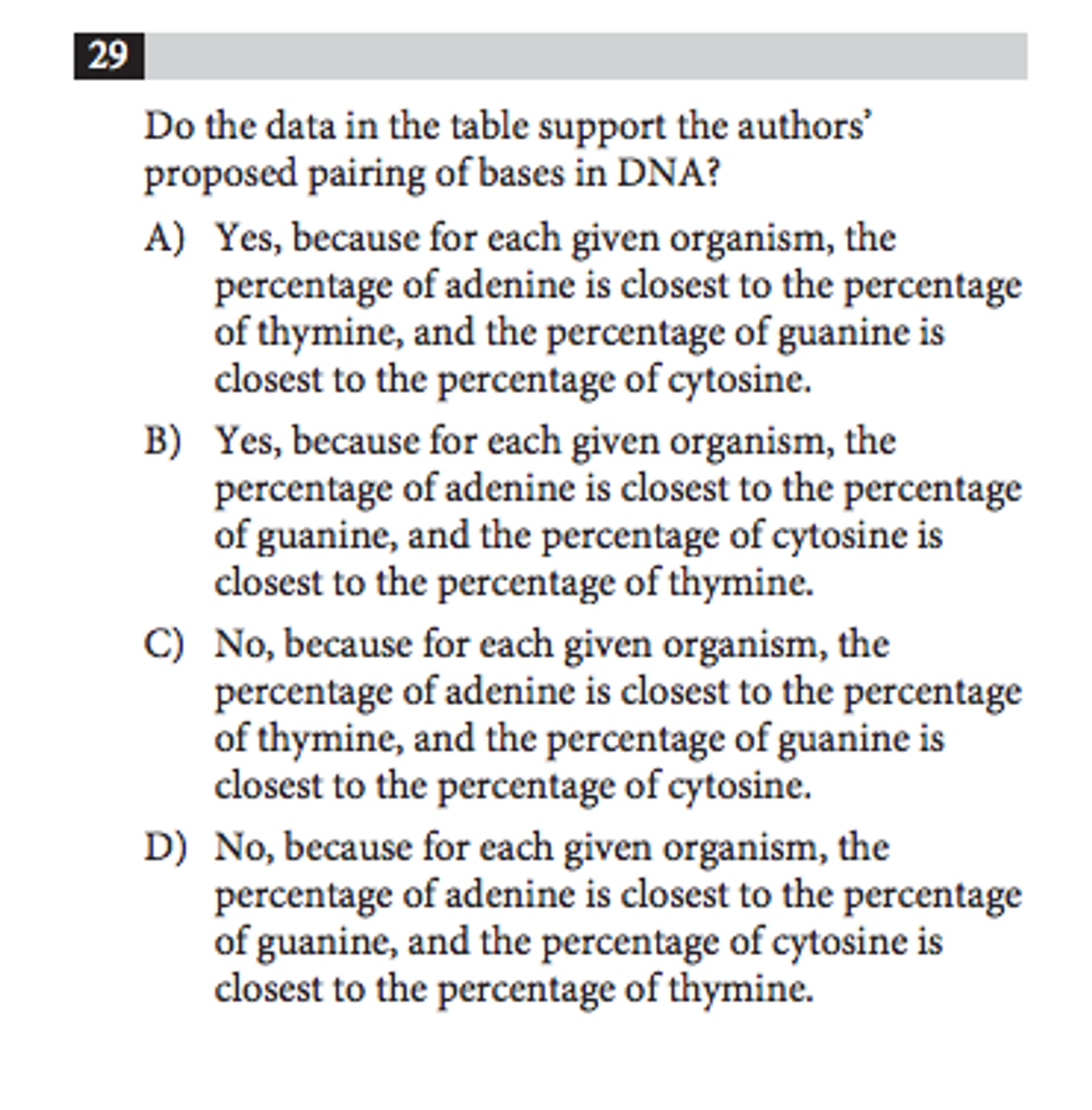Top Strategies for Reading SAT Passages Effectively
Author
Hartwell
Date Published

The SAT Reading section presents a demanding challenge. Not only must you maintain focus for a full 65-minute session, but you also need to actively seek evidence within each passage to support your answers.
This section can be time-consuming and filled with misleading "distractor" answers, but with the right strategies, you can learn to avoid common mistakes. This guide will explore the most effective techniques for reading passages efficiently and achieving a high score on the SAT Reading section.
To begin, let's take a closer look at the structure of the redesigned passages you'll encounter on the test.
Types of Reading Passages on the SAT
Since the introduction of the 1600-point SAT in 2016, every SAT Reading section includes four individual passages and one paired passage. These passages cover a range of subjects: one is from U.S. and World Literature. Two are from History and Social Studies, and the remaining two focus on Science. Each passage (or paired set) contains approximately 500 to 750 words, and at least one will be accompanied by a graph, table, or chart.
In total, you'll need to answer 52 Reading questions. The Reading section is administered in a single 65-minute block, making it the first section of the SAT.
To tackle this section effectively, you can employ several reading strategies. Before exploring these techniques, let's first review the different types of Reading questions you'll encounter.
Types of Reading Questions on the SAT
The redesigned SAT evaluates reading comprehension through a variety of question types, assessing your ability to identify main ideas, analyze details, make inferences, interpret vocabulary in context, determine function, recognize author techniques, support answers with evidence, and analyze data from graphs, tables, or charts.
A key focus of the SAT is your ability to connect evidence to your answers and break down logical arguments. Keeping this in mind will help you pay attention to relevant details and deeper meanings as you read. Here are the primary ways the College Board will test your reading comprehension skills:
1.Big Picture / Main Point
These questions ask about the overall purpose of the passage. Is it describing an issue or event? Is it aiming to review, prove, contradict, or hypothesize?
2.Little Picture / Detail
Detail-oriented questions refer to specific lines in the passage. They may ask what a sentence means or how it functions within the overall text.
3.Inference
These questions require you to interpret the meaning of one or more lines in the passage. While they involve some reasoning, there is always one clearly correct answer—nothing is left open-ended.
4.Vocabulary in Context
These questions direct you to a specific word in the passage and ask how it functions within a sentence. Rather than testing obscure vocabulary, they often focus on common words with meanings that shift depending on context.
5.Function
Function questions ask about the role a phrase, sentence, or paragraph plays within the passage. These connect directly to your understanding of the passage’s overall structure and purpose.
6.Author Technique
These questions explore the author’s tone, style, or other rhetorical techniques. When working with paired passages, you may be asked to compare and contrast different author techniques or perspectives.
7.Evidence Support
These questions require you to choose a line or set of lines that best support your answer to a previous question. Since they rely on earlier answers, they can serve as a helpful way to check your reasoning—but they also pose a risk. If your previous answer was incorrect, you may find a corresponding incorrect choice in the evidence question. These questions often appear in the form: “Which choice provides the best evidence for the previous question?”
8.Data Analysis
A newer question type, these involve interpreting information from graphs, charts, or tables. You may be asked something like, “Which claim about traffic congestion is supported by the graph?” The most challenging versions of these questions may combine data analysis with inference, asking something like, “The author is least likely to support which interpretation of the data in this figure?”
Understanding the structure of both passages and questions will improve your approach to the SAT Reading section. As you practice, pay close attention to how each question fits into these categories. Next, let’s explore the best strategies for reading passages effectively, maximizing comprehension, and managing your time efficiently.
How to Read the Passages
Students use different strategies when tackling SAT passages—some read the passage first, others review the questions beforehand, and some prefer a “back-and-forth” method. However, the five-step approach outlined below is a proven technique that works for most students. It helps you grasp the key points of the passage before reading and allows you to save time while processing information.
With five passages and 52 questions to answer in just 65 minutes, time management is crucial. Review these steps, test this approach, and see if it helps you maintain focus and work efficiently as you prepare for the SAT Reading section.
Step 1: Preview the Questions
Before diving into the passage, take a quick glance at the associated questions. This gives you a sense of what to look for and where to direct your attention.
Even if the passage explores an intriguing topic—like space mining or Japanese marriage customs—your goal is not deep reading. Instead, your focus should be on answering the questions accurately and efficiently. You can always explore the subject further after the SAT, but for now, prioritize the task at hand.
As you scan the questions, identify and circle any Big Picture / Main Point questions. These can typically be answered more easily after you've read the passage, so it’s best to save them for last. Here’s an example from College Board’s SAT Practice Test 1:

For specific line reference questions, mark the indicated lines in the passage so you can pay special attention to them as you read.
This marking and prioritization process doesn’t mean you won’t read the entire passage—it simply helps you know what to focus on before you begin. By identifying key areas in advance, you can read more efficiently and avoid unnecessary rereading.
While this approach saves time for most students, it's important to experiment and find the method that works best for you.
Step 2: Read the Introduction Blurb
Before diving into the passage, take a moment to read the brief introduction at the beginning. This blurb provides valuable context about the passage’s source, author, and subject matter.
Ask yourself:
- When was this passage written?
- Who is the author, a novelist, a scientist, a historian?
- What is the likely purpose or tone of the passage?
Understanding these details upfront can help you anticipate the passage’s style, argument, and key themes, making it easier to comprehend as you read.

Step 3: Read the Passage Efficiently
Now, it’s time to read the passage—but instead of reading slowly and analyzing every word, focus on skimming strategically to identify key points.
Pay close attention to:
- The last line of the introduction (often the thesis statement)
- The opening sentences of each paragraph (which usually introduce the main idea)
- The conclusion (which often summarizes the passage’s key argument)
Also, watch for transitional words and phrases like, however, additionally, despite, which signal shifts in ideas or the continuation of a thought. Recognizing these markers will help you follow the structure of the passage without getting bogged down in unnecessary details.
Adopt an Engaged Mindset
Your attitude while reading can significantly impact your comprehension. It’s easier to absorb information when you're genuinely interested in the subject. Even if a passage initially seems dull, try to approach it with curiosity, you might find the topic more engaging than you expect.
Believe it or not, SAT passages often feature fascinating and unexpected information across a variety of subjects. While you may not love every passage, chances are you'll find at least a few that capture your interest!
Step 4: Answer the Questions Strategically
Now, it's time to tackle the questions. Save the ones you circled for last, especially the Big Picture / Main Point questions, since they are easier to answer after you've gone through the passage.
Predict Before Looking at Answer Choices
Before checking the multiple-choice options, try to predict your own answer based on your understanding of the passage. The SAT is designed to include tempting but misleading choices, so forming your own answer first can help you avoid getting distracted by cleverly worded incorrect options.
Handling Chart and Graph Questions
If your passage includes a chart, graph, or table, you’ll likely see one or two data interpretation questions. Sometimes, you can answer these without reading the passage, but in most cases, having context will be beneficial.
Many of these questions go beyond simple data analysis. They may ask whether the data supports a claim made in the passage or how the author incorporates data to prove or refute an argument. To answer them correctly, you’ll need to locate evidence in both the passage and the data.


For example, some questions require you to cross-reference a specific claim in the passage with the data presented in a chart. These often function as "little picture/detail" questions, asking you to verify small but important pieces of information.
Efficient Answering Techniques
- The detail questions typically follow the passage’s chronological order, meaning the first one will reference the beginning of the passage, and later ones will correspond to later sections. This can help you locate information efficiently.
- Instead of switching back and forth between your test booklet and the bubble sheet after each question, consider marking answers in your booklet first and transferring them in chunks. This can save time and reduce errors—but make sure you don’t run out of time and that your answers stay properly aligned on the bubble sheet!
Step 5: Answer the General Purpose Questions & Final Review
Once you’ve completed the other questions, go back to the Big Picture / Main Point questions you circled earlier. By this point, you should have a solid understanding of the passage, making these broader questions easier to answer.
Finally, carefully transfer all your answers to the bubble sheet if you haven’t already. Double-check that your responses are correctly aligned to avoid unnecessary mistakes.
Tips and Strategies for Effective Critical Reading
In addition to honing your reading efficiency, there are several other strategies you can employ as you tackle questions and prepare for this section. A classic method that remains effective is the process of elimination. An unexpected yet beneficial preparation tactic is to practice answering ACT Science questions. Continue reading for more helpful strategies that will enable you to excel in the SAT Reading section.
Focus on Eliminating Incorrect Answers
The answer choices will not be overtly wrong; in fact, they are often phrased in a way that makes each one seem plausible. This means you need to be vigilant in filtering out distractions your mind may encounter. You might be tempted by answers that appear somewhat correct, but you must stop yourself from getting sidetracked. If you find yourself excessively rationalizing or justifying a choice, it's likely not the correct one.
Remember, there is only one answer that is completely accurate, and it shouldn’t require extensive overthinking. Typically, incorrect answers tend to be either too specific or too broad, suggest a relationship in reverse order, or introduce a concept that is entirely irrelevant. This article elaborates on methods to eliminate wrong options, guiding you to the one correct answer.
A helpful guideline is to steer clear of extreme language. Terms like "never" or "always" are rarely found in the correct response. However, in the spirit of this advice, I should be cautious about stating absolutes!
Another crucial mindset, which the updated SAT will explicitly encourage, is one that actively seeks evidence.
Support Your Answers with Evidence
Rather than selecting an answer that merely "feels" right, ensure you can substantiate all your choices with evidence directly drawn from the text. None of the questions require you to possess any prior knowledge of the topic; they are designed to assess your reading comprehension. All your answers should be supported and validated by the passage itself. Even if an answer were to be factually incorrect (which, don’t worry, it won't be), the focus of the questions is solely on the passage, not your existing knowledge.
This is a crucial aspect to keep in mind for the SAT, as it will present texts that you may be somewhat familiar with or that are particularly relevant to history or contemporary issues. To answer questions accurately, it is essential to set aside your personal biases or opinions and base your understanding solely on the given text. Fortunately, the new evidence support questions will serve as a helpful reminder to continually refer back to the text for your responses.
You will likely encounter two to three evidence support questions per passage that explicitly ask you to select specific lines that validate your answer to a prior question. These questions help you verify your reasoning and ensure that your choice is substantiated.
Even in cases where a question is not immediately followed by an evidence support question, you should maintain the practice of backing up your answers with evidence directly from the text. By doing so, you can be confident that your answer relies on the words on the page rather than your own assumptions.
Practice Data Analysis Using ACT Science Questions
For those who deem themselves language enthusiasts, the presence of charts, tables, and graphs in SAT Reading questions might be less than appealing. What role does this data play in a reading comprehension section? According to the College Board, the incorporation of data analysis aims to bridge the gap between the new SAT and the skills students are acquiring in the classroom, along with essential real-world capabilities.
You can enhance your data interpretation skills by practicing with ACT Science questions. While these questions may require more specialized scientific knowledge, they still demand the same interpretive skills that the SAT Reading questions do. By consulting charts and graphs for your answers and seeking evidence within the data, you will be better equipped for data and evidence-based Reading questions on the SAT.
Familiarize Yourself with Literary Terms and Techniques
The SAT Reading section primarily focuses on understanding the function of words, sentences, and paragraphs, as well as the overall argument presented. Thus, much of your SAT reading practice should center on unraveling the logic and structure of a text.
However, it's also beneficial to review common literary terms such as theme, style, tone, foreshadowing, and imagery, along with the vocabulary used to describe them. Beyond just knowing the definitions, you should practice identifying and applying these terms in the texts you read. While it's one thing to understand that tone can be somber, hopeful, or suspicious, it’s another to accurately assess the tone of a specific passage.
Engaging in test prep will help you improve steadily, especially when combined with as much reading and analysis as you can do both inside and outside of the classroom.
Study Vocabulary
As previously mentioned, the vocabulary questions in SAT Reading are not intended to assess your knowledge of obscure, rarely used words. Instead, these questions may focus on relatively common words that are employed in an unconventional manner within the context of the passage. Therefore, it is important to practice interpreting meanings based on context, as well as understanding the denotations (literal meanings) and connotations (implied meanings) of words.
For a simple illustration, consider how the phrase "Nice job" can convey two very different connotations in these contexts:
1."Nice job," Kathy snickered at her friends after tripping you in the cafeteria.
2."Nice job!" Kathy exclaimed admiringly as you showed her the bowl you crafted in ceramics.
Grasping the meanings of words with multiple interpretations and discerning tone depends heavily on context. Given these insights and strategies, how can you enhance your reading skills?
Practice, Practice, Practice
The SAT Reading section does not always align closely with your high school English curriculum, even though the redesigned test is more connected than ever with its focus on evidence-based reading. While your English classes may encourage creativity and support various interpretations, SAT Reading questions will only have one definitively correct answer, which must be determined and backed by the text itself.
You can improve your ability to quickly read and answer questions through rigorous test preparation, which will enhance your reading comprehension skills, as well as your time management and pacing. Engaging with reading materials outside of class, such as news articles from the New York Times, can further refine your ability to analyze logic, break down arguments, and identify the author's perspective and tone.
If you are applying for a humanities or social sciences major, it is especially important to achieve a high score on the SAT Reading section. Take practice tests, identify areas for improvement, understand your mistakes, and practice frequently and effectively so that you can excel in Reading. With the right approach and ample test preparation, you might even attain a perfect score in Reading.
Related Posts

Learn how the Digital SAT works! From sections to scoring, get the insights you need to prepare effectively and boost your college admissions game.

Discover how often the SAT is held and how to choose the test center for you. Get tips on scheduling and factors to consider for a smooth experience.